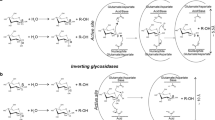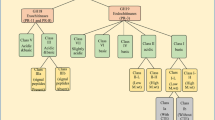Summary
Arabinogalactan proteins (AGPs) are proteoglycans secreted by plant cells that have been implicated in plant growth and development. Most AGPs cloned to date possess highly labile glycosylphosphatidylinositol (GPI) lipid anchors. These anchors transiently attach AGPs to the plasma membrane before they are released into the cell wall following GPI anchor hydrolysis. We have isolated and partially sequenced the protein core of an AGP purified from styles ofNicotiana alata. The protein sequence data were utilised to clone the AGP's gene,NaAGP4. This AGP shares about 78% sequence identity with the tomato AGP LeAGP-1. RNA gel blot analyses of different plant organs indicate thatNaAGP4 is expressed in the same tissues and at similar levels asLeAGP-1. Furthermore,NaAGP4 likeLeAGP-1 is rapidly suppressed by tissue wounding and by pathogen infection. We believe NaAGP4 and LeAGP-1 are the first described examples of orthologous AGPs from different plant species. In contrast, another AGP fromN. alata, NaAGP1, is comparatively unaffected by wounding and pathogen infection, although this AGP is expressed in similar tissues and at similar levels as NaAGP4.
Similar content being viewed by others
Abbreviations
- AGP:
-
arabinogalactan protein
- βGlcY:
-
β-glucosyl Yariv reagent
- GPI:
-
glycosylphosphatidylinositol
- HRGPs:
-
hydroxyproline-rich glycoproteins
- RACE:
-
random amplification of cDNA ends
- RP-HPLC:
-
reversed-phase high-performance liquid chromatography
- RT-PCR:
-
reverse transcriptase polymerase chain reaction
References
Aceto J, Kieber-Emmons T, Cines D (1999) Carboxy-terminal processing of the urokinase receptor: implications for substrate recognition and glycosylphosphatidylinositol anchor addition. Biochemistry 19: 992–1001
Agrios G (1997) Plant pathology. Academic Press, San Diego
Altschul S, Madden T, Schäffer A, Hang J, Hang Z, Miller W, Lipman D (1997) Gapped BLAST and PSI-BLAST: a new generation of protein database search programs. Nucleic Acids Res 25: 3389–3402
Baldwin TC, McCann MC, Roberts K (1993) A novel hydroxyproline-deficient arabinogalactan protein secreted by suspension-cultured cells ofDaucus carota: purification and partial characterization. Plant Physiol 103: 115–123
Campbell P, Braam J (1999) Xyloglucan endotransglycosylases: diversity of genes, enzymes and potential. Trends Plant Sci 4: 361–366
Carpita N, Gibeaut D (1993) Structural models of primary cell walls in flowering plants: consistency of molecular structure with the physical properties of the walls during growth. Plant J 3: 1–30
Chen C-G, Cornish EC, Clarke AE (1992) Specific expression of an extensin-like gene in the style ofNicotiana alata. Plant Cell 4: 1053–1062
Chen J, Varner JE (1985) Isolation and characterization of cDNA clones for carrot extensin and a proline-rich 33-kDa protein. Proc Natl Acad Sci USA 82: 4399–4403
Cosgrove DJ (1999) Enzymes and other agents that enhance cell wall extensibility. Annu Rev Plant Physiol Plant Mol Biol 50: 391–117
Ding L, Zhu JK (1997) A role for arabinogalactan-proteins in root epidermal cell expansion. Planta 203: 289–294
Du H, Simpson RJ, Moritz RL, Clarke AE, Bacic A (1994) Isolation of the protein backbone of an arabinogalactan-protein from the styles ofNicotiana alata and characterization of a corresponding cDNA. Plant Cell 6: 1643–1653
—, Clarke AE, Bacic A (1996a) Arabinogalactan-proteins: a class of extracellular matrix proteoglycans involved in plant growth and development. Trends Cell Biol 6: 411–414
—, Simpson RJ, Clarke AE, Bacic A (1996b) Molecular characterization of a stigma-specific gene encoding an arabinogalactan-protein (AGP) fromNicotiana alata. Plant J 9: 313–323
Gane A, Craik D, Munro S, Howlett G, Clarke A, Bacic A (1995) Structural analysis of the carbohydrate moiety of arabinogalactan-proteins from stigmas and styles ofNicotiana alata. Carbohydr Res 1995: 67–85
Gao M, Showalter A (1999) Yariv reagent treatment induces programmed cell death in Arabidopsis cell cultures and implicates arabinogalactan protein involvement. Plant J 19: 321–331
— — (2000) Immunolocalization of LeAGP-1, a modular arabinogalactan-protein, reveals its developmentally regulated expression in tomato. Planta 210: 865–874
—, Kieliszewski M, Lamport D, Showalter A (1999) Isolation, characterization and immunolocalization of a novel, modular tomato arabinogalactan-protein corresponding to the LeAGP-1 gene. Plant J 18: 43–55
He Z, Cheeseman I, He D, Kohorn B (1999) A cluster of five cell wall-associated receptor kinase genes, Wakl-5, are expressed in specific organs of Arabidopsis. Plant Mol Biol 39: 1189–1196
Knox JP (1995) The extracellular matrix in higher plants: developmentally regulated proteoglycans and glycoproteins of the plant cell surface. FASEB J 9: 1004–1012
— (1999) Intriguing, complex and everywhere: getting to grips with arabinogalactan-proteins. Trends Plant Sci 4: 123–125
Komalavilas P, Zhu J, Nothnagel E (1991) Arabinogalactan-proteins from the suspension culture medium and plasma membrane of rose cells. J Biol Chem 266: 15956–15965
Li SX, Showalter AM (1996) Cloning and developmental/stress-regulated expression of a gene encoding a tomato arabinogalactan protein. Plant Mol Biol 32: 641–652
Mau SL, Chen CG, Pu ZY, Moritz RL, Simpson RJ, Bacic A, Clarke AE (1995) Molecular cloning of cDNAs encoding the protein backbones of arabinogalactan-proteins from the filtrate of suspension-cultured cells ofPyrus communis andNicotiana alata. Plant J 8: 269–281
McCabe PF, Valentine TA, Forsberg LS, Pennell RI (1997) Soluble signals from cells identified at the cell wall establish a developmental pathway in carrot. Plant Cell 9: 2225–2241
McDowell J, An Y, Huang S, McKinney E, Meagher R (1996) The Arabidopsis ACT7 actin gene is expressed in rapidly developing tissues and responds to several external stimuli. Plant Physiol 111: 699–711
Nam J, Mysore K, Zheng C, Knue M, Matthysse A, Gelvin S (1999) Identification of T-DNA taggedArabidopsis mutants that are resistant to transformation byAgrobacterium. Mol Gen Genet 261: 429–438
Nielsen H, Engelbrecht J, Brunak S, Heijne Gv (1997) A neural network method for identification of prokaryotic and eukaryotic signal peptides and prediction of their cleavage sites. Int J Neural Syst 8: 581–599
Nothnagel EA (1997) Proteoglycans and related components in plant cells. Int Rev Cytol 175: 195–291
Oxley D, Bacic A (1995) Microheterogeneity of N-glycosylation on a stylar self-incompatibility. Glycobiology 5: 517–523
— — (1999) Structure of the glycosyl-phosphatidylinositol membrane anchor of an arabinogalactan-protein fromPyrus communis suspension-cultured cells. Proc Natl Acad Sci USA 6: 14246–14251
Peles E, Nativ M, Lustig M, Grumet M, Schilling J, Martinez R, Plowman GD, Schlessinger J (1997) Identification of a novel contactin-associated transmembrane receptor with multiple domains implicated in protein-protein interactions. EMBO J 16: 978–988
Pogson BJ, Davies C (1995) Characterization of a cDNA encoding the protein moiety of a putative arabinogalactan protein fromLycopersicon esculentum. Plant Mol Biol 28: 347–352
Reiter W-D (1999) The molecular analysis of cell wall components. Trends Plant Sci 3: 27–32
Roy S, Jauh GY, Hepler PK, Lord EM (1998) Effects of Yariv phenylglycoside on cell wall assembly in the lily pollen tube. Planta 204: 450–458
—, Holdaway-Clarke T, Hackett G, Kunkel J, Lord E, Hepler P (1999) Uncoupling secretion and tip growth in lily pollen tubes: evidence for the role of calcium in exocytosis. Plant J 19: 379–386
Samaj J, Ensikat H, Baluska F, Knox J, Barthlott W, Volkmann D (1999a) Immunogold localization of plant surface arabinogalactan-proteins using glycerol liquid substitution and scanning electron microscopy. J Microsc 193: 150–157
—, Braun M, Baluska F, Ensikat H, Tsumuraya Y, Volkmann D (1999b) Specific localization of arabinogalactan-protein epitopes at the surface of maize root hairs. Plant Cell Physiol 40: 874–883
Sambrook F, Fritsch EF, Maniatis T (1989) Molecular cloning: a laboratory manual. Cold Spring Harbor Laboratory Press, Cold Spring Harbor, NY
Schultz C, Hauser K, Lind J, Atkinson A, Pu Z-Y, Anderson M, Clarke A (1997) Molecular characterisation of a cDNA sequence encoding the backbone of a style-specific 120 kDa glycoprotein which has features of both extensins and arabinogalactan-proteins. Plant Mol Biol 35: 833–845
—, Gilson P, Oxley D, Youl J, Bacic A (1998) GPI-anchors on arabinogalactan-proteins: implications for signalling in plants. Trends Plant Sci 3: 426–431
—, Johnson K, Currie G, Bacic A (2000) The classical arabinogalactan-protein gene family of Arabidopsis. Plant Cell 12: 1751–1767
Sherrier D, Prime T, Dupree P (1999) Glycosylphosphatidylinositol-anchored cell-surface proteins from Arabidopsis. Electrophoresis 20: 2027–2035
Showalter A (1993) Structure and function of plant cell wall proteins. Plant Cell 5: 9–23
Sommer-Knudsen J, Clarke AE, Bacic A (1996) A galactose-rich, cell-wall glycoprotein from styles ofNicotiana alata. Plant J 9: 71–83
Svetek J, Yadav M, Nothnagel E (1999) Presence of a glycosylphosphatidylinositol lipid anchor on rose arabinogalactan proteins. J Biol Chem 274: 14724–14733
Thompson J, Higgins D, Gibson T (1994) CLUSTAL W: improving the sensitivity of progressive multiple sequence alignment. Nucleic Acids Res 22: 4673–4680
Udenfriend S, Kodukula K (1995) How glycosyl-phosphatidylinositol-anchored membrane proteins are made. Annu Rev Biochem 64: 563–591
Wadsworth G, Redinbaugh M, Scandalios J (1988) A procedure for the small-scale isolation of plant RNA suitable for RNA blot analysis. Anal Biochem 172: 279–283
Willats WGT, Knox JP (1996) A role for arabinogalactan-proteins in plant cell expansion: evidence from studies on the interaction of beta-glucosyl Yariv reagent with seedlings ofArabidopsis thaliana. Plant J 9: 919–925
Youl JJ, Bacic A, Oxley D (1998) Arabinogalactan-proteins fromNicotiana alata andPyrus communis contain glycosylphosphatidylinositol membrane anchors. Proc Natl Acad Sci USA 95: 7921–7926
Author information
Authors and Affiliations
Additional information
Dedicated to Professor Brian E. S. Gunning on the occasion of his 65th birthday
Rights and permissions
About this article
Cite this article
Gilson, P., Gaspar, Y.M., Oxley, D. et al. NaAGP4 is an arabinogalactan protein whose expression is suppressed by wounding and fungal infection inNicotiana alata . Protoplasma 215, 128–139 (2001). https://doi.org/10.1007/BF01280309
Received:
Accepted:
Issue Date:
DOI: https://doi.org/10.1007/BF01280309




